Please note that the financials in this complete free business plan are completely fictitious and may not match the text of the business plan below. This free business plan demonstration purposes only. If you are interested in purchasing the completed editable MS Word and Excel documents for this business plan, please click the button below! Also, the text of the business plan is formatted with a fully automated table of contents.
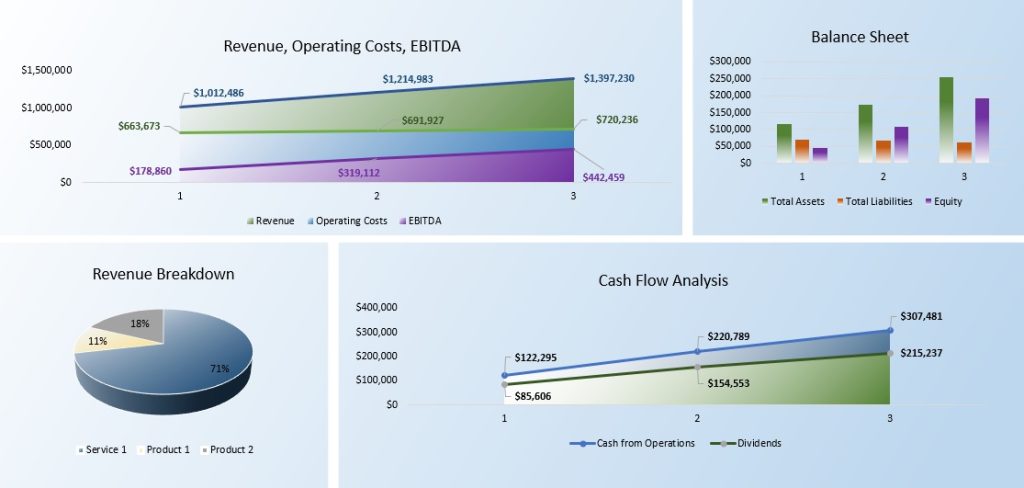
1.0 Executive Summary
The purpose of this business plan is to raise $250,000 for the development of a dollar store while showcasing the expected financials and operations over the next three years. Dollar Store, Inc. (“the Company”) is a New York based corporation that will sell general merchandise items for $1.00 or less to its customers in its targeted market. The Company was founded by John Doe.
1.1 Operations
As stated above, the Dollar Store intends to provide people with items at a cost of $1.00. Within the Company’s location, the business will maintain the following divisions within the market: • General Merchandise • Toys • Kitchen Products • Candy • Candles and Decorations The business, through scientific cost cutting measures, will have the ability to offer its customers most items at a price of $1.00. The third section of the business plan will further describe the services offered by the Dollar Store.
1.2 The Financing
Mr. Doe is seeking to raise $250,000 from as a bank loan. The interest rate and loan agreement are to be further discussed during negotiation. This business plan assumes that the business will receive a 10 year loan with a 9% fixed interest rate.
1.3 Mission Statement
The Dollar Store’s mission is to become the recognized leader in its targeted market for providing items at a cost of $1.00 or less.
1.4 Management Team
The Company was founded by John Doe. Mr. Doe has more than 10 years of experience in the retail management industry. Through his expertise, he will be able to bring the operations of the business to profitability within its first year of operations.
1.5 Sales Forecasts
Mr. Doe expects a strong rate of growth at the start of operations. Below are the expected financials over the next three years.
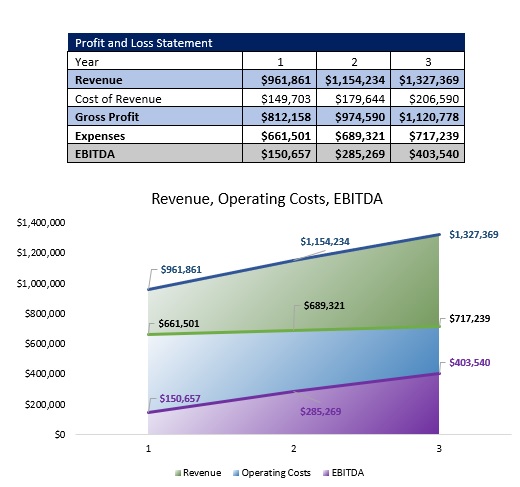
1.6 Expansion Plan
The Founder expects that the business will aggressively expand during the first three years of operation. Mr. Doe intends to implement marketing campaigns that will effectively target individuals within the target market.
2.0 Company and Financing Summary
2.1 Registered Name and Corporate Structure
Dollar Store, Inc. The Company is registered as a corporation in the State of New York.
2.2 Required Funds
At this time, the Dollar Store requires $250,000 of debt funds. Below is a breakdown of how these funds will be used:
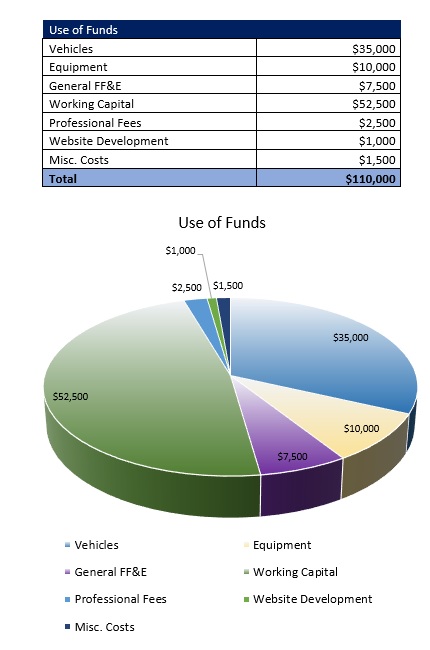
2.3 Investor Equity
Mr. Doe is not seeking an investment from a third party at this time.
2.4 Management Equity
John Doe owns 100% of the Dollar Store, Inc.
2.5 Exit Strategy
If the business is very successful, Mr. Doe may seek to sell the business to a third party for a significant earnings multiple. Most likely, the Company will hire a qualified business broker to sell the business on behalf of the Dollar Store. Based on historical numbers, the business could fetch a sales premium of up to 4 times earnings.
3.0 Operations
Through its retail location, the Company will provide a full line of general merchandise products that are available for $1.00. The store will have a minimum of 3,000 square feet and will feature approximately 6 full time employees that will manage each aspect of the store. At this time, Mr. Doe is developing a number of connections with regional and national level wholesalers/inventory liquidators that will supply the business with the products to be resold to the general public. Mr. Doe anticipates that the business will generate gross margins of approximately 70% on each dollar of revenue generated by the business. This will be accomplished through bulk purchases of inventories from wholesalers and liquidators. As the Company will carry an expansive line of inventory, it is difficult to list all of the products that will be sold through the retail location. However, and as stated in the executive summary, the business will carry inventories such as general merchandise, cleaning supplies (mops, brooms, etc), kitchen supplies (pots, pans, napkins), and small packaged food goods such as beef jerky, candy, and caned goods.
4.0 Strategic and Market Analysis
4.1 Economic Outlook
This section of the analysis will detail the economic climate, the dollar store industry, the customer profile, and the competition that the business will face as it progresses through its business operations. Currently, the economic market condition in the United States is moderate. The meltdown of the sub prime mortgage market coupled with increasing gas prices has led many people to believe that the US is on the cusp of a double dip economic recession. This slowdown in the economy has also greatly impacted real estate sales, which has halted to historical lows. However, dollar stores tend to operate with great economic stability as people, during economic downturns, will begin to more frequently shop at these locations in an effort to reduce daily living expenses. This is one of the few industries that tends to thrive during deleterious economic climates.
4.2 Industry Analysis
There are over 24,275 businesses that sell general merchandise for $1.00. These businesses have had a resurgence of growth over the last two years with many people actively seeking to save money whenever possible. The general economic decline of the later part of this decade caused many operators to develop stores that offer all of their merchandise for exclusively $1.00. Among these businesses, the industry generates more than $28 billion dollars per year, and provides jobs for more than 283,000 people. Each year, average annual payrolls reach $3 billion dollars. Variety and dollar stores have had growth of approximately 5% per year, which is in higher than the growth of the general economy.
4.3 Customer Profile
The Company expects that the average customer of the Dollar Store will have the following demographics: • Household/family income of $25,000 to $30,000 per year (in US Dollars) or less. • Has a family of four or five people. • Is seeking to buy affordable products for their low income budget. • Will regularly use the Company’s store once a quality rapport has been developed. Through these demographics, the Company will structure its advertising and marketing campaigns to appeal to the above demographics.
4.4 Competitive Analysis
There is a sizable amount of competition among super markets to gain a loyal customer base. Many supermarket sell items that are identical to one another, and as such, the business will maintain a competitive advantage by maintaining a flat fee pricing structure where products cost $1.00. However, with the current economic climate, Management may see more companies developing low cost (or flat $1.00 fee pricing structures) retail establishments that sell items similar to that of the Dollar Store. Mr. Doe is actively seeking to develop relationships with wholesalers and liquidators that can provide the business with quality merchandise, which will provide the business with a competitive advantage over existing dollar stores and potential new businesses entering the market.
5.0 Marketing Plan
The Dollar Store intends to maintain an extensive marketing campaign that will ensure maximum visibility for the business in its targeted market. Below is an overview of the marketing strategies and objectives of the Company.
5.1 Marketing Objectives
- Establish relationships with wholesalers and inventory liquidators within the regional market.
- Implement a local campaign with the Company’s targeted market via the use of flyers, local newspaper advertisements, and word of mouth advertising.
- Develop an online presence by developing a website and placing the Company’s name and contact information with online directories.
5.2 Marketing Strategies
Retail marketing will be the most difficult portion of the marketing strategy. This is because one of the essential elements to reaching a retail audience is that the Company must build a brand affinity with the customer. Management fully expects to enlist the help of a local marketing firm to reach the Company’s targeted low income consumer. The discount retail product industry is an extremely competitive market, and as such, the Management of Dollar Store, Inc. will need to develop a marketing program that creates a branded image edge over its competition. The Company will maintain a moderate level of traditional print and media advertising, which will be exclusively geared towards the Dollar Store’s lower income consumer. These traditional advertisements include billboards and distribution of flyers/circulars in controlled circulation publications. This will ensure that the target audience is continually aware of Dollar Store’s grand openings and regular discount promotions. Finally, the business will develop a small online platform (registered with several online directories) so that people can easily find the Company’s location by searching (via sites like Google, Yahoo, etc.) for low cost retailers and dollar stores.
5.3 Pricing
In this section, describe the pricing of your services and products. You should provide as much information as possible about your pricing as possible in this section. However, if you have hundreds of items, condense your product list categorically. This section of the business plan should not span more than 1 page.
6.0 Organizational Plan and Personnel Summary
6.1 Corporate Organization

6.2 Organizational Budget

7.0 Financial Plan
7.1 Underlying Assumptions
- Dollar Store, Inc. will have an annual revenue growth rate of 7% per year.
- The Owner will acquire $250,000 of debt funds to develop the business.
- The loan will have a 10 year term with a 9% interest rate.
7.2 Sensitivity Analysis
The Company’s revenues are not sensitive to changes in the general economy. People demand certain dollar store items as a necessity, and the business only expects that an economic catastrophe could result in decreases in revenue. The Company’s dollar programs for general merchandise will ensure that Dollar Store, Inc. continues to thrive despite deleterious changes in the general economy.
7.3 Source of Funds

7.4 General Assumptions

7.5 Profit and Loss Statement

7.6 Cash Flow Analysis
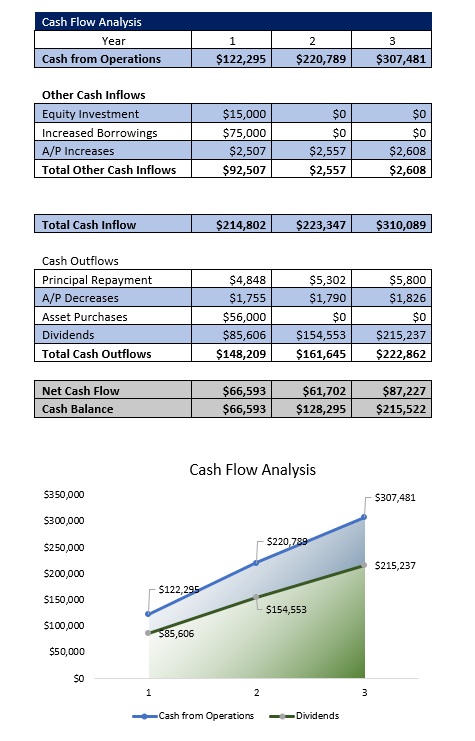
7.7 Balance Sheet

7.8 Breakeven Analysis
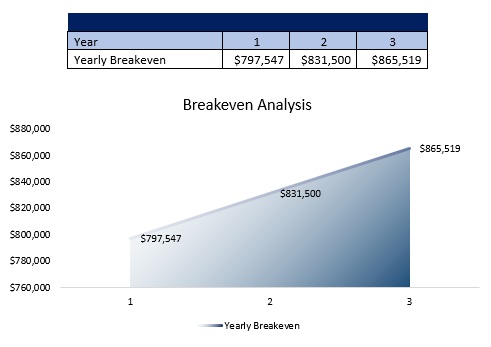
7.9 Business Ratios

